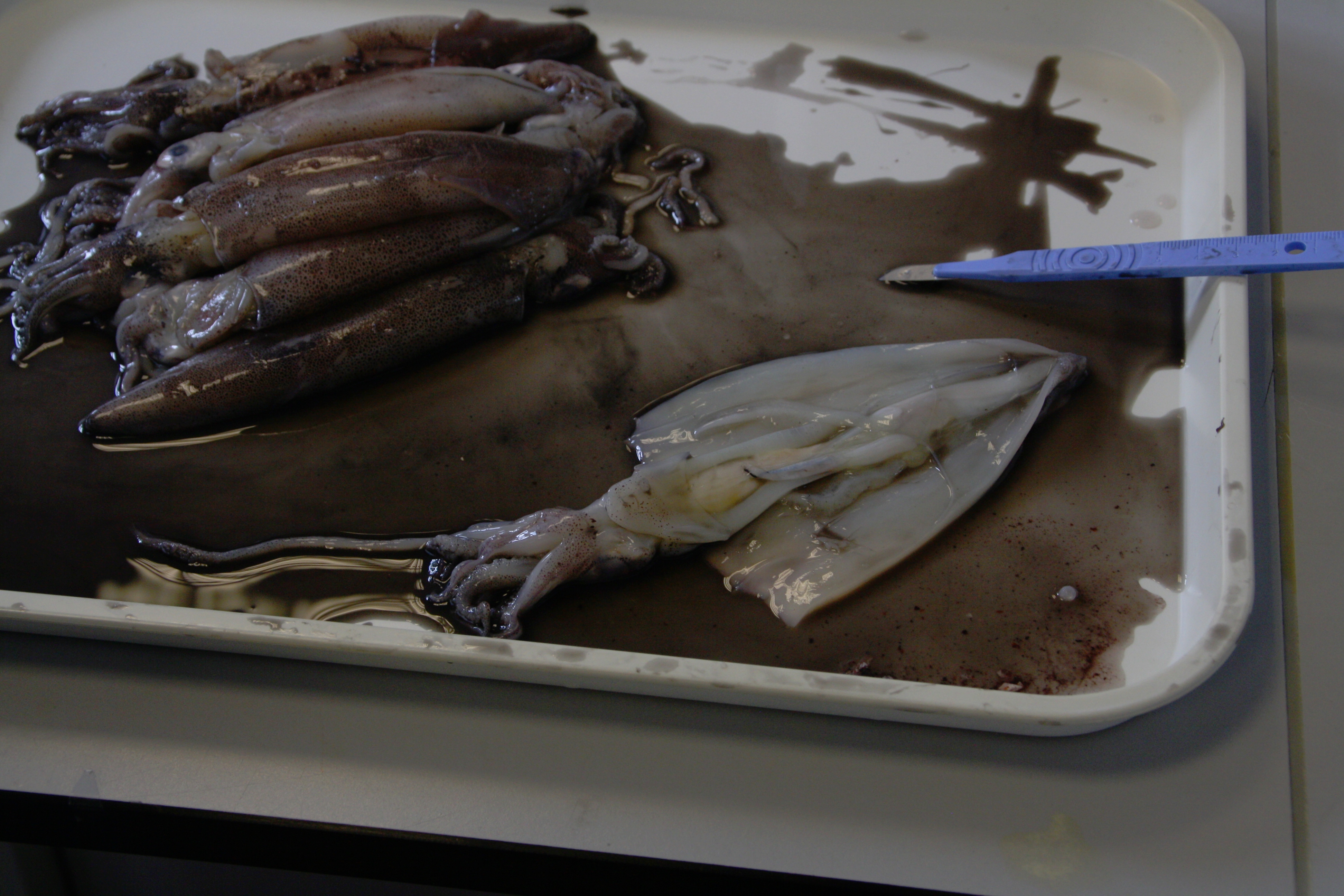Team:Cambridge/Experiments/Squid Dissection and Tissue Sample
From 2011.igem.org
(→Squid Dissection and Tissue Samples) |
|||
| Line 3: | Line 3: | ||
Obtaining DNA coding for reflectin proteins was the vital first step in our project. [http://en.wikipedia.org/wiki/Loligo Loligo] tissue was sourced from fishing bait suppliers and culinary wholesalers in order to attempt genomic DNA extraction. From our literature search we discovered that the reflectin gene from E. scolopes contains no introns, so genomic DNA should be suitable for expression in E. coli. | Obtaining DNA coding for reflectin proteins was the vital first step in our project. [http://en.wikipedia.org/wiki/Loligo Loligo] tissue was sourced from fishing bait suppliers and culinary wholesalers in order to attempt genomic DNA extraction. From our literature search we discovered that the reflectin gene from E. scolopes contains no introns, so genomic DNA should be suitable for expression in E. coli. | ||
| - | ==Squid Dissection | + | ==Squid Dissection== |
Specimens of what we identified as [http://www.marlin.ac.uk/speciesinformation.php?speciesID=3718 ''Loligo vulgaris''] and [http://en.wikipedia.org/wiki/Opalescent_Inshore_Squid ''Loligo opalescens''] were dissected for examination. Samples of skin tissue and eye cups were taken from ''L. vulgaris'' for further imaging. No obvious iridescence was seen in the skin sample under a dissection microscope or by confocal microscopy. In accordance with [http://rsif.royalsocietypublishing.org/content/early/2011/02/14/rsif.2010.0702.full Holt ''et al''], we found clearly visible iridescence in the tissue surrounding the eye lens. | Specimens of what we identified as [http://www.marlin.ac.uk/speciesinformation.php?speciesID=3718 ''Loligo vulgaris''] and [http://en.wikipedia.org/wiki/Opalescent_Inshore_Squid ''Loligo opalescens''] were dissected for examination. Samples of skin tissue and eye cups were taken from ''L. vulgaris'' for further imaging. No obvious iridescence was seen in the skin sample under a dissection microscope or by confocal microscopy. In accordance with [http://rsif.royalsocietypublishing.org/content/early/2011/02/14/rsif.2010.0702.full Holt ''et al''], we found clearly visible iridescence in the tissue surrounding the eye lens. | ||
| Line 13: | Line 13: | ||
File:CAM Iridescent.JPG | ''L. vulgaris'' eye cup, showing Bragg reflectance | File:CAM Iridescent.JPG | ''L. vulgaris'' eye cup, showing Bragg reflectance | ||
</gallery> | </gallery> | ||
| + | |||
| + | ==Tissue samples for DNA extraction== | ||
| + | |||
| + | To isolate squid genomic DNA as a template for PCR, samples of squid tissue were cut from representative specimens. Internal organs and tissue were dissected with the aim of minimizing external contamination. ''L. vulgaris'' specimens were obtained from two different sources, so samples were taken from both. | ||
{{Template:Team:Cambridge/CAM_2011_TEMPLATE_FOOT}} | {{Template:Team:Cambridge/CAM_2011_TEMPLATE_FOOT}} | ||
Revision as of 10:07, 21 July 2011
Obtaining DNA coding for reflectin proteins was the vital first step in our project. [http://en.wikipedia.org/wiki/Loligo Loligo] tissue was sourced from fishing bait suppliers and culinary wholesalers in order to attempt genomic DNA extraction. From our literature search we discovered that the reflectin gene from E. scolopes contains no introns, so genomic DNA should be suitable for expression in E. coli.
Squid Dissection
Specimens of what we identified as [http://www.marlin.ac.uk/speciesinformation.php?speciesID=3718 Loligo vulgaris] and [http://en.wikipedia.org/wiki/Opalescent_Inshore_Squid Loligo opalescens] were dissected for examination. Samples of skin tissue and eye cups were taken from L. vulgaris for further imaging. No obvious iridescence was seen in the skin sample under a dissection microscope or by confocal microscopy. In accordance with [http://rsif.royalsocietypublishing.org/content/early/2011/02/14/rsif.2010.0702.full Holt et al], we found clearly visible iridescence in the tissue surrounding the eye lens.
Tissue samples for DNA extraction
To isolate squid genomic DNA as a template for PCR, samples of squid tissue were cut from representative specimens. Internal organs and tissue were dissected with the aim of minimizing external contamination. L. vulgaris specimens were obtained from two different sources, so samples were taken from both.
 "
"




